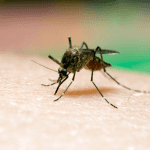 Scientists in Maryland and Burkina Faso are working with genetically-modified fungus that uses toxin in spider venom to kill malarial mosquitoes.
Scientists in Maryland and Burkina Faso are working with genetically-modified fungus that uses toxin in spider venom to kill malarial mosquitoes.
The project is the brainchild of entomologists at the University of Maryland.
Dramane Ouedraogo has visited his son’s grave in the Burkina Faso village of Soumousso every day since the two-year-old died of malaria.
“If we can find a solution against this disease which killed my child, other people we will thank god. They should do everything to eradicate this disease,” he said, squatting beside the mound of brown dirt where his son’s body was laid.
In this West African village plagued by malarial mosquitoes, scientists are conducting an experiment to test whether a fungus genetically-engineered to produce a toxin found in spider venom can provide a breakthrough in the worldwide fight against malaria.
The project is the brainchild of entomologists at the University of Maryland, who engineered the DNA of the fungus to deliver a toxin produced by Australian Blue Mountains funnel-web spiders.
The toxin kills the malaria-carrying Anopheles mosquito when the fungus comes in contact with insect blood.
Brian Lovett, a Ph.D. candidate at the University of Maryland and lead author on the study, said the idea is to target the mosquitoes using the natural characteristics of the fungus and spider venom.
“Out of the box, if they land anywhere on the outside of a mosquito, they’ll recognize that they’re on a mosquito and they’ll burrow their way into the mosquito,” Lovett said.
After successful lab trials, the U.S.-based team headed to Burkina Faso, where scientists there produced and tested the toxin-infused fungus in a national research lab.
“The mosquitoes fly around the room, looking for bait to feed, so they feed on the (calf). After feeding, mosquitoes look for a place to rest, they usually go on the wall. Given they are attracted to black, they will rest on the treated cloth which is black. That is when they make contact with the fungus spores and the fungus starts to germinate inside them and that is what kills them,”
Researchers reported dramatic results.
“Within two generations, we’ve killed 99 percent of the mosquitoes. So it caused the mosquito population to collapse,” St. Leger said, adding that this type of mosquito produces two generations in about 45 days.
By employing the fungus in tandem with conventional insecticides, the scientists believe they can prevent mosquitoes from developing resistance and the same technology could one day be used to combat other mosquito-borne illnesses, such as Zika and Dengue.














